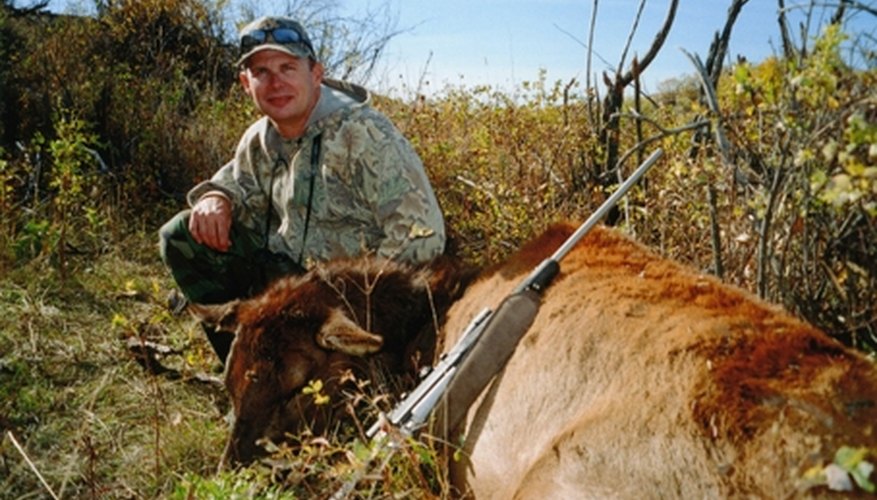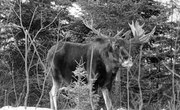
Pulling the trigger on your elk was the easy part. Now the real job begins. Like all game animals, proper field dressing is important in order to have great-tasting venison for the table. Because of the nature of this task, it is easy to get discouraged and do a less-than-adequate job. Take the time to dress the animal correctly, and you will find it is not that difficult. Weather and terrain can play big factors in elk hunting. If the weather is frigid or the animal is on a steep slope, stop and form a plan of action before beginning. One man cannot carry around a 600 or 700 pound animal. Hunting with a buddy can really pay off if either one is successful. Follow the steps below to field dress your elk.
Items you will need
Rope
Clean rag or paper towels
Water
How to Gut an Elk
Use your helper or the rope to spread the legs apart on the elk. Remove enough of your clothing so it is not ruined by blood or body cavity contents. Set out the paper towels or rag and open the water so they are accessible later for cleanup.
Ready the anus for removal by making a circular cut around the anus. Make deep cuts to help loosen the anus. This is sometimes awkward to do, but stick with it until the anus is free. If the elk is a cow, also include the genital area. If a bull, cut the penis and testicles free and sever the urethra close to the anus. When the intestines are removed, this whole area should pull back through the pelvic opening.
Carefully start slitting the abdominal wall. Start in the middle of the belly and work up to the rib cage, then work back towards the rear of the elk. Make an initial incision and then carefully try to pull up on the abdominal wall with one hand, freeing up enough space so that your knife can cut the wall without nicking the intestines. Your knife blade will be facing upward, so be careful not to cut yourself. Depending how the elk is laying, there may be a lot of pressure which will try to push the intestines out. Push the intestines aside and continue cutting till the cavity is open.
Starting in the middle of the neck, cut next to the windpipe all the way down to the chest. Sever the windpipe at the middle of the neck and cut the windpipe free. You are essentially doing the same thing to the windpipe that you did to the anus. At the base of the neck, use your knife to free the windpipe where it runs into the upper chest of the elk. Cut the diaphragm free from the cavity, so that the organs inside the rib cage will come free. Reach up into the cavity and pull the windpipe through the chest where you had cut earlier. Grab the organs with one hand and pull while cutting any connective tissue that is restraining the organs from being removed. Proceed slowly and deliberately--it is easy to cut yourself when working inside the chest.
Continue pulling the organs free, letting them spill out onto the ground. Pay attention to the diaphragm area, as you may have to make another cut there to break the organs free. Continue cutting any connective tissue until the intestines and anus are free of the body. If the skin around the anus is not totally free, continue cutting until the anus pulls free. Be careful not to cut the intestines or bladder when removing the intestines. At this point, all internal organs and intestines should be free from the cavity.
Move the body cavity contents away from the elk. Untie the legs and roll the elk over so the chest is down.This will let any blood that is inside drain from the body cavity.
With the elk now field dressed, use the towels and water to clean yourself and your knife.
Warnings
- Be extremely careful when using your knife inside of the elk.
Tips
- If the elk is lying on a slope with the head higher than the rear, remove the organs as described above. If the rear is higher than the head, start by removing the intestines first. This will let you take advantage of gravity.
- Extend your index finger along the back of the knife blade to help guide it while inside the elk.
Tips
- If the elk is lying on a slope with the head higher than the rear, remove the organs as described above. If the rear is higher than the head, start by removing the intestines first. This will let you take advantage of gravity.
- Extend your index finger along the back of the knife blade to help guide it while inside the elk.
Warnings
- Be extremely careful when using your knife inside of the elk.
Writer Bio
Daniel Ray has been writing for over 15 years. He has been published in "Florida Sportsman" magazine. He holds an FAA airframe and powerplant license and FCC radiotelephone license, and is also a licensed private pilot. He attended the University of South Florida.



